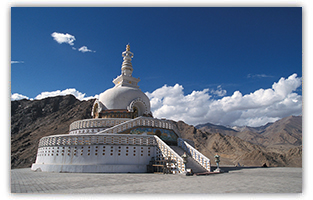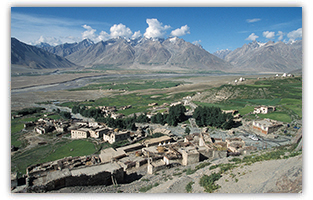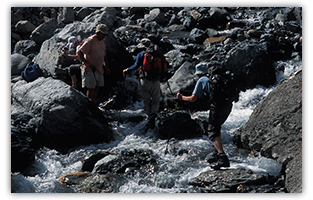Cultural Tours
Safari Tours
Trekking Tours
- Gangabal - Trek
- Lamayaru Alchi - Trek
- Lamayaru Darcha - Trek
- Marcha - Trek
- Spituk - Trek
- Water - Trek
- Zanaskar - Trek
Rafting
Beaches
Angling
Ecotourism
Leh- Ladakh Cultural Tours
 Ladakh the northern frontier of India ,where Afghanistan, Pakistan and China meet ,is an area of high altitudes, glaciers , streams and charming, valleys hidden among some of the tallest mountain in the world - Karakoram range. The journey by road from Srinagar over the Zoji La ( La means pass in Ladakhi ) climbing unaccustomed heights traverses cold, grey crags and boulders , and vast yellow desert – like plains.
Ladakh the northern frontier of India ,where Afghanistan, Pakistan and China meet ,is an area of high altitudes, glaciers , streams and charming, valleys hidden among some of the tallest mountain in the world - Karakoram range. The journey by road from Srinagar over the Zoji La ( La means pass in Ladakhi ) climbing unaccustomed heights traverses cold, grey crags and boulders , and vast yellow desert – like plains.
Fa – hien , the Chinese traveler , seems to have been the first to leave us an account of his visit to Ladakh .The name he uses for Ladakh is Kie- chha or land of snow . In fact, when he travelled across it in AD 399, he described it as “ the Land where snow never melts and only corn ripens. “Ladakh is indeed a place of extremes : the summer heat of 38 degees celsius plummets to minus 38 degrees in winter. The sunlight is intense and so is the cold. The dry heat of the day is followed by icy winds and the cold glitter of amazingly bright stars. One actually feels nearer to the heavens, thanks to the height of the land, which is around 4,600 meters.
At first glance Ladakh appears to be a bastion of Tibetan Buddhism and culture, but actually there are several layers of influence from other religions, races and cultures preserved in this remote outpost of the Himalaya .Today it is a perfect picture of cultural synthesis: Buddhists, Muslims – mostly Shiites – and a sprinkling of Christians live a perfect harmony with one another all taking pride in the unique Ladakhi way of life. Hence the fascination that ladakh and quiet valleys nestling in its mountains – Zanaskar, Chushul and Nubra –exert over those in search of unique and refreshing experience today.
Situated as it was on the crossroads of High Asia , Ladakh was the central point at which several routes of central Asian met. Merchants from Tibet , China, Afghanistan, the Punjab and Kashmir would converge here, making it an exciting and bustling hub of commercial activity. Caravans of horses and mule laden with gold , silver, porcelain, Yarkandi carpets, numdahs, fur , wool and tea - both black and green - in the small, compressed brick form, destined for the bazaars of India would come from China Tibet and central Asia.
Ladakh itself enjoyed a monopoly on all Pashmina trade, through it produced only a negligible quantity of the silky wool known as pashm ( which comes form the underbelly of the pashmina goat that thrives on high level pastures chiefly in Tibet ) from which the remarkably soft and warm pashmina shawls of Kashmir are made. Besides , Ladakh is the habitat of the Tibetan antelope, locally known as the Stos which produces the softer than silk, feather light ,yet unbelievably warm wool TOOSH. Shwals made from toosh are actually called Shahtoosh and perhaps the most expansive fabric in the world.
From earlist times the fortunes of Ladakh have been linked with those of the Kashmir valley.The ladakh are mixture of several races who either passed through or setteled here. The earliest inhabitants were probably the Dards ,whose original homeland was Gilgit in Pakistan. The Dards were converted to Buddhism when missionaries from India trvelled north in the first century the Varayana ( Vehicle of the Thunderbolt ) school of Buddhism.
 Ladakhi Buddhists, like their Tibetan counterparts, believe that the Buddha , having found Nivana , is moved by compassion for suffering humanity and therefore keeps returning to the earth in different incarnations in order to help other attain salvation .Hence the concept of the thousand Buddha , a recurrent motif In the murals of gompas in Ladakh .There is also a rigidly estabalished hierarchy of Lamas. The head of each gompa is known as the Kushak .The spiritual head is , is of course ,the Dalai Lama, the incarnate Buddha or Avalokitesvara. Once the supreme spiritual as well as temporal authority of Tibet but now living in exile in Dharamsala ( Himachel Pradash ) in India .
Ladakhi Buddhists, like their Tibetan counterparts, believe that the Buddha , having found Nivana , is moved by compassion for suffering humanity and therefore keeps returning to the earth in different incarnations in order to help other attain salvation .Hence the concept of the thousand Buddha , a recurrent motif In the murals of gompas in Ladakh .There is also a rigidly estabalished hierarchy of Lamas. The head of each gompa is known as the Kushak .The spiritual head is , is of course ,the Dalai Lama, the incarnate Buddha or Avalokitesvara. Once the supreme spiritual as well as temporal authority of Tibet but now living in exile in Dharamsala ( Himachel Pradash ) in India .
Apart from gompas and lamas, the other visible symbols of Buddhism in ladakh are the ubiquitous Chhorten, the mani wall and the prayer wheels.The chhorten ( a type of Stupa ) is a solid mound of masonary and is erected in honour of a holy man or important lama after his death .
The earlist settlers of Ladakh were perhaps nomadic herdsmen as is suggested by the rock carvings at Drass ( 147 kms from Srinagar ) and Zanaskar ( south of Leh ). In the first century AD Ladakh became a part of the Kushan empire ,which spread from Central Asia to India. In the eighth century it was again part of the great Kashmiri king Lalitaditya empire. But later, for the next hundred years or so, ties with Tibet came to be established and strengthened .The first Tibetan ruling monarch was Nyima Gon, who established his kingdom in ladakh in the tenth century.
By the early thirteenth century AD ,islam ,too was advancing from the north –west. Frequent raids by rulars like Zain-Ul-Abiddin ( Badshah ) and Mirza Haidar Dughlat the adventurer from Kashgar in Central Asis,resulted in Kargilnand some of its adjoining areas converting to Islam. In fact the ladakhki prince Rinchen deprived of his throne in Ladakh, advanced into Kashmir and taking advantage of the political turmoil,married Kotam Rani, and converted to Islam , as Buddhism had died out in Kashmir and the Hindus ,with their rigid caste system ,would not accept him.he thus became the first Muslim ruler of Kashmir.
From 1555 to 1575 ladakh had the good furtune of being ruled by Tashi Namgyal who unified the land , build many Buddhist temples ,He established the monastery at Phiyang .Unfortunately ,from 1600 onwards ladakh once again became a battleground for the control of this rich trading centre among the rival powers of Central Asia and Baltistan. But in spite of armed onslaughts, Buddhism survived. Even though a ladakhi king , jamyang married the daughter of the Balti ruler, Ali Mir, who was a muslim. Ironically enough it is this Muslim princess , Gyal Katun, who bore her husband the son who proved to be the greatest Buddhist king in Ladakh’s history ,Sengge Namgyal ( 1616 -42 ) A deeply religious man and a great statesman at the same time, he immersed himself in the twin tasks of restoring to ladhak its religious as well as secular glory. He conquered Zanskar and Guge (now in Tibet) through suffering a defeat by the Mughals , Who were at this time in control of Kashmir. In retaliation and in a fit of anger, Sengge Namgyal closed the trade routes from Kaskmir for about twenty four years, which proved to be economically disastrous for Ladakh .This apart, Senggen Namgyal not only repaired many damaged and vandalized monasteries,but also established many more.Among these are the famous Hemis Gompa and the Hanla Gompa.He also built many status of the Buddha , Mani walls and the seven story leh Palace,
 After Sengge Namgyal’s death , Ladakh once again broke up into a number of separate kingdoms.1n 1663 the mughals king Aurangzeb’s forces marched up to the borders of Ladakh,it was than the first mosque came up in Leh.Attempts were made to convert the Buddhists to Islam and later to Christianty with the coming of European missionaries,but this hardly had any success.It was only in the nineteenth century that two Bristish travelers, Moorcroft and Cunningham,came on sec ret political missions on behalf of Bristish.The strategic importance of this northern outpost ,straddled across the hightest plateau in the world. And the prospect of lucrative trade with Tibet, China and Russia that friendly ties with Lakdakh opened, was an irresistible proposition for the Bristish.They were particularly anxious to gain a foothold in a place from where they could put an effective check.They were thwarted by their treaty with Ranjit Singh.But after his death, When Gulab Singh acquired Kashmir, Ladakh became a part of the state of Jammu and Kashmir in 1846.The occupation of Tibet by China in the 1950s and inhospitable heights of Ladakh occupied by China. This plateau, known as AKSAI Chin,
After Sengge Namgyal’s death , Ladakh once again broke up into a number of separate kingdoms.1n 1663 the mughals king Aurangzeb’s forces marched up to the borders of Ladakh,it was than the first mosque came up in Leh.Attempts were made to convert the Buddhists to Islam and later to Christianty with the coming of European missionaries,but this hardly had any success.It was only in the nineteenth century that two Bristish travelers, Moorcroft and Cunningham,came on sec ret political missions on behalf of Bristish.The strategic importance of this northern outpost ,straddled across the hightest plateau in the world. And the prospect of lucrative trade with Tibet, China and Russia that friendly ties with Lakdakh opened, was an irresistible proposition for the Bristish.They were particularly anxious to gain a foothold in a place from where they could put an effective check.They were thwarted by their treaty with Ranjit Singh.But after his death, When Gulab Singh acquired Kashmir, Ladakh became a part of the state of Jammu and Kashmir in 1846.The occupation of Tibet by China in the 1950s and inhospitable heights of Ladakh occupied by China. This plateau, known as AKSAI Chin,
Zanaskar ( 4000 Mts) is the valley that stands in between Kargil and Lamayuru in the north and Kistwar and Manali in the south.Interestingly enough , the Zanaskar ,which cuts across the Zanskar range to join the Indus, become a good raod for vehicles to cross over the gorge into padum once it frozen solid in winter.
The Nubra valley , at a slightly lower elevation, has a more temperate climate. It also has a number of hot springs. The main rivers, apart from the Indus which has its source in Tibet are - are Shoyk, Nubra , Zanaskar ,Suru and Drass, and these also join the Indus.The fields,meadows and popular plantations near the rivers present an agreeable contrast to the bleakness of the surrounding mountains.
There are three large and beautiful salt lakes, Tsomorari, Pangong and Rupshu..
The Ladakh script is close to Devanagari and most printing in the past was done in gompas by lamas. The ladakhi national epic, Kesar Saga, has pre-Tibetan elements and has acquired the colors of all the religio- cultural influences that have left an imprint on Ladakh. Ladakh craft have strong Tibetan or Kashmiri influence.Genuinely ladakhi is the Pittu, a king of tweed, which is very thick and warm.The brocade bordered Thangkas, which hang on Gompa walls and also decorate and bless ladakhi homes,Also available are low,carved and painted tables and exquisitely shaped copper pots for serving GUR GUR tea and Chhang.

